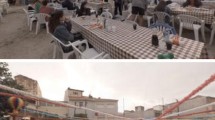Abstract
This paper is written from a human factors perspective and discusses research into some of the side-effects of head-coupled immersive virtual reality. The paper provides a broad overview of the history of virtual reality and highlights some of the important current human factors issues. Reasons why side-effects of virtual reality technology may be expected are then discussed with particular reference to the literature on motion sickness and simulator sickness. A study is described which set out to document the frequency of occurrence and severity of side-effects of immersion in virtual reality. One hundred and fifty subjects took part in this study and were immersed in a virtual environment for 20 minutes. Sixty-one percent of the subjects were documented as reporting symptoms at some point during the 20 minute immersion period and a 10 minute post-immersion period. Five percent of the subjects had to withdraw from the study due to the severity of their symptoms. This finding led to further research that attempted to reduce the side-effects observed. Studies investigating the use of adaptation and the anti-motion sickness drug hyoscine hydrobromide are described. Both of these methods of reducing the side-effects of virtual reality proved successful with the hyoscine proving to be a very rapid method of symptom reduction.
Similar content being viewed by others
Explore related subjects
Discover the latest articles, news and stories from top researchers in related subjects.References
Biocca, F. (1992). Will simulation sickness slow down the diffusion of virtual environment technology?Presence,1(3): 334–343.
Bricken, W. (1991). Virtual reality: Directions of growth. InProc. of Virtual Reality 91: Impacts and Applications (Meckler, London).
Chappelow, J.W. (1988). Simulator sickness in the Royal Air Force : A survey. InProc. AGARD 433: Motion Cues in Flight Simulation and Simulator Induced Sickness.
Gower, D.W., Lilienthal, M.G., Kennedy, R.S. and Fowlkes, J.E. (1988). Simulator sickness in US Army and Navy fixed- and rotary-wing flight simulators. InProc. AGARD 433. Motion Cues in Flight Simulation and Simulator Induced Sickness.
Havron, M.D. and Butler, L.F. (1957). Evaluation of training effectiveness of the 2FH2 helicopter flight trainer research tool. Naval Training Device Center, Port Washington, New York NAVTRADEVCEN 1915-00-1.
Jennings, R.T., Davis, R.J. and Santy, P.A. (1988). Comparison of aerobic fitness and space motion sickness during the shuttle program.Aviation, Space, and Environmental Medicine 59: 448–451.
Kennedy, R.S., Lilienthal, M.G., Berbaum, K.S., Baltzley, D.R. and McCauley, M.E. (1989).Simulator sickness in U.S. Navy flight simulators.Aviation, Space, and Environmental Medicine 60: 106.
Kennedy, R.S., Odenheimer, R.C., Baltzley, D.R., Dunlap, W.P. and Wood, C.D. (1990). Differential effects of scopolamine and amphetamine on microcomputer-based performance tests.Aviation, Space & Environmental Medicine 61: 615–621.
Kennedy, R.S., Lane, N.E., Berbaum, K.S. and Lilienthal, M.G. (1993a). Simulator sickness questionnaire: An enhanced method for quantifying simulator sickness.The International Journal of Aviation Psychology 3 (3): 203–220.
Kennedy, R.S. (1993b). Personal Communication.
Mon-Williams, M., Wann, J.P. and Rushton, S. (1993). Binocular vision in a virtual world: visual deficits following the wearing of a head-mounted display.Ophthalmic and Physiological Optics 13: 387–391.
Reason, J. (1974).Man in Motion: The Psychology of Travel. Cox and Wyman Ltd.
Schmedtje, J.F., Oman, C.M., Letz, R. and Baker, E.L. (1988). Effects of scopolamine and dextroamphetamine on human performance.Aviation, Space, and Environmental Medicine 59: 407–410.
Simulator Sickness Field Manual MOD 4 (1989). Naval Training Systems Center, Orlando, Florida.
Stone, R.J. (1991). Virtual reality — the serious side; where next, and how? InProc. of Virtual Reality 91: Impacts and Applications (Meckler, London).
Treisman, M. (1977). Motion sickness: An evolutionary hypothesis.Science 197: 493–495.
Ungs, T.J. (1989). Simulator induced syndrome: Evidence for long-term after effects.Aviation, Space, and Environmental Medicine 60: 252–255.
Wood, C.D., Manno, J.E., Manno, B.R., Redetzki, H.M., Wood, M. and Vekovius, W. A. (1984). Side-effects of antimotion sickness drugs.Aviation, Space, and Environmental Medicine 55(2): 113–116.
Author information
Authors and Affiliations
Rights and permissions
About this article
Cite this article
Regan, C. An investigation into nausea and other side-effects of head-coupled immersive virtual reality. Virtual Reality 1, 17–31 (1995). https://doi.org/10.1007/BF02009710
Issue Date:
DOI: https://doi.org/10.1007/BF02009710




